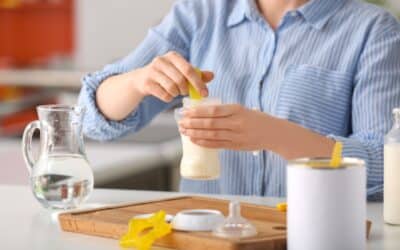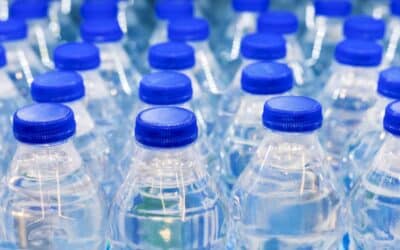As a new parent struggling to achieve the perfect mix for your baby’s formula, this comprehensive guide on essential tools for mixing baby formula is exactly what you need.
Ensuring the correct balance of water and formula powder is crucial for your baby’s health and development, as it provides the necessary nutrients, calories, and hydration.
This guide delves into fundamental and advanced tools for mixing baby formula, including bottles, nipples, formula dispensers, measuring cups, bottle brushes, sterilizers, formula makers, bottle warmers, and formula mixers.
By using these tools, you’ll not only save time but also guarantee a perfectly mixed and heated bottle, allowing you to focus more on bonding with your baby.
Furthermore, this guide offers valuable tips and best practices for mixing baby formula, ensuring you get it right every time.
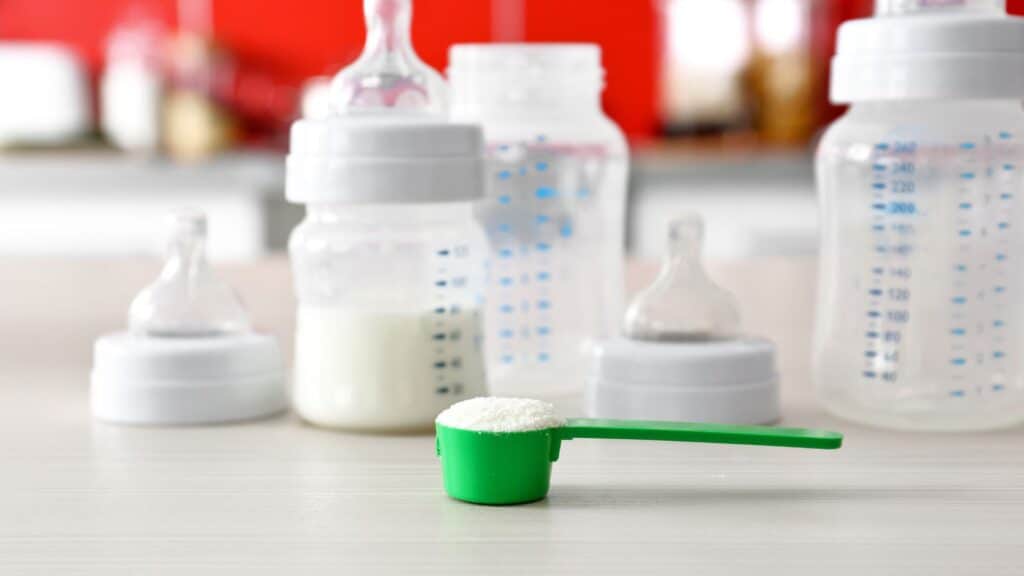
Why Properly Mixing Baby Formula Matters
Properly mixing baby formula is crucial for a baby’s health and development. Accurate water and formula powder proportions ensure the infant receives the right balance of nutrients, calories, and hydration. Over-diluting the formula may lead to malnutrition, insufficient weight gain, and developmental delays.
Conversely, concentrated formula can cause dehydration, gastrointestinal distress, and kidney problems. By adhering to the manufacturer’s instructions, caregivers can provide a safe, balanced, and nutritious diet for optimal growth and well-being.
Basic Tools for Mixing Baby Formula
Preparing baby formula is essential for many parents, and having the right tools can make the process easier and more efficient. A baby formula maker is a game-changer that simplifies this daily task, ensuring that your baby receives the perfect blend every time.
Here are the fundamental tools needed for mixing baby formula, including:
Baby Formula Maker Machine:
Formula makers are one of the most innovative products in the baby formula market. These devices are designed to create perfectly mixed formula bottles with the touch of a button. Here are some features of formula makers:
- Pre-measured formula dispensing: These innovative machines not only dispense formula but also ensure that your baby receives the correct nutrition. By dispensing the appropriate amount of formula based on the desired bottle size, parents can confidently provide their baby with a well-balanced meal.
- Instant water heating: Formula makers often come with built-in water heaters, so you don’t have to worry about preparing warm water separately for your baby’s bottle.
- Customizable settings: Many formula makers allow you to choose the preferred temperature and bottle size, ensuring that each bottle is perfectly suited to your baby’s needs.
This innovative device automates the entire formula preparation process. With just a press of a button, it measures, mixes, and warms the formula to the ideal temperature.
The best baby formula makers on the market offer customizable settings for consistency and temperature, ensuring your baby gets the perfect formula every time.
Formula Dispenser:
Formula dispensers are handy tools designed to store pre-measured amounts of baby formula powder, streamlining the bottle preparation process. They make it easy for parents to have the right amount of formula ready for mixing whenever needed, making feeding time more efficient and less messy. The best formula dispensers are compact and portable, ideal for on-the-go parents.
These dispensers come in various styles, such as stackable containers or multiple compartments within a single unit. By pre-measuring the formula and storing it in the dispenser, parents can quickly prepare a bottle by simply pouring the pre-portioned formula into the bottle, adding water, and shaking. This convenience allows for a stress-free feeding experience, especially when out and about with your baby.
Mixing Pitcher:
A mixing pitcher is an essential tool for parents who prefer to prepare a larger batch of formula in advance. This handy container allows you to mix multiple servings of formula at once, ensuring a smooth and lump-free consistency. The best mixing pitchers have a built-in agitator that thoroughly mixes the formula, preventing air bubbles and clumps.
Quality Baby Bottles:
The primary container for holding and feeding baby formula is a baby bottle. Various types of baby bottles are available in the market, including glass, plastic, and stainless steel. Each material has pros and cons, so choosing a bottle that best suits your preferences and your baby’s needs is essential.
For instance, glass bottles are eco-friendly and chemical-free but can be more substantial and breakable. On the other hand, plastic bottles are lightweight and durable but may contain harmful chemicals if not made from BPA-free material.
Bottle Warmers
A bottle warmer is essential for parents who want to ensure that their baby’s formula is at the perfect temperature. Some features of bottle warmers include:
- Fast heating: Bottle warmers can heat your baby’s bottle in just a few minutes, making them ideal for those late-night feedings when time is of the essence.
- Temperature control: Many bottle warmers come with adjustable temperature settings, allowing you to choose the perfect temperature for your baby’s formula.
- Safety features: Most bottle warmers have built-in safety features, such as automatic shut-off and timers, to prevent overheating and ensure safe use.
A warm bottle is crucial for providing a comfortable feeding experience for your baby. That’s why having a bottle warmer is essential for parents who want to ensure that their baby’s formula is at the perfect temperature. Some features of bottle warmers include:
Nipples:
Nipples are part of the baby bottle the baby will suck on to receive the formula. Depending on your baby’s age and feeding preferences, they come in different sizes, shapes, and flow rates.
It is crucial to select the appropriate nipple size and flow rate for your baby to avoid choking hazards and ensure a comfortable feeding experience. Some popular nipple materials are silicone and latex, with silicone being more durable and less likely to cause allergies.

Measuring Cups:
Accurate measurement is crucial when preparing baby formula to ensure your baby receives the appropriate nutrients. Using a measuring cup specifically designed for baby formula can help achieve the correct water and formula powder proportions.
Some formula brands provide a scoop with the appropriate measurements, but it’s essential to double-check with the formula instructions and use a separate measuring cup if necessary.
Formula Mixers
Formula mixers are designed to thoroughly mix baby formula, eliminating clumps and ensuring a smooth consistency. Some benefits of using a formula mixer include the following:
- Efficient mixing: Using a formula mixer helps to break down clumps and create a smooth texture, making it easier for your baby to digest the formula.
- Portability: Many formula mixers are compact and portable, allowing you to mix your baby’s formula on the go.
- Easy cleaning: Formula mixers are generally easy to clean, with some models even being dishwasher-safe, making them a convenient option for busy parents.
Bottle Brushes and Sterilizers:
Proper cleaning and sterilization of all baby-feeding equipment are crucial to maintain your baby’s health. Bottle brushes help clean the inside of bottles and nipples, while sterilizers (steam, microwave, or electric) help eliminate bacteria and germs.
Infant formula preparation can be a time-consuming and sometimes messy task. However, some advanced tools are available that can make the process easier and more efficient and ensure a perfectly mixed formula every time.
These advanced tools are available to make formula feeding easier and more convenient. These tools include formula makers, bottle warmers, and mixers, which can help you choose the best option for your baby’s formula feeding.
Best Practices for Mixing Baby Formula
Mixing and storing the formula correctly is essential to provide your baby with the right nutrients. Here are some tips and best practices for mixing baby formula, ensuring it’s done right every time.
Choose the Right Formula:
Before mixing, ensure you have chosen the right formula for your baby. Consult with your pediatrician for guidance on selecting an appropriate formula based on your baby’s age, dietary needs, and potential allergies.
Cleanliness is Key:
Prior to handling baby formula, make sure to wash your hands thoroughly. Additionally, ensure that all bottles, nipples, and mixing utensils, including baby formula dispensers, are clean and sterilized to prevent contamination.
Measure the Formula Accurately:
Always follow the manufacturer’s instructions on the formula packaging for the correct water-to-formula ratio. To measure the formula, use the scoop provided and level it off with a clean, flat surface like a knife’s edge. Avoid packing the formula tightly or using heaping scoops.
Use the Correct Water Temperature:
The water you mix the formula should be lukewarm, not hot or cold. Most manufacturers recommend using water that has been boiled and then cooled to room temperature. Alternatively, you can use bottled or filtered water but always check with your pediatrician first.
Mix the Formula Thoroughly:
Pour the measured water into the baby bottle, then add the formula powder. Secure the bottle with the nipple and cap and shake it vigorously for at least 15-20 seconds to ensure the formula is fully dissolved and well mixed. Avoid stirring, as this can create air bubbles that may cause your baby to swallow air during feeding, leading to gas or discomfort.
Check for Clumps:
After shaking the formula, it’s important to inspect it for any remaining clumps. If you find any, simply shake the bottle again or use a clean utensil to break up the clumps. This will ensure a smooth consistency and prevent any potential choking hazards for your baby.
Test the Temperature:
Before feeding your baby, it’s essential to test the formula temperature by placing a few drops on the inside of your wrist. The formula should feel lukewarm, not hot or cold, to provide the most comfortable feeding experience for your little one.
Proper Storage:
If you need to store prepared formula, keep it in the refrigerator for no more than 24 hours. Always label the bottle with the date and time it was prepared. Any leftover formula from feeding should be discarded, as bacteria from the baby’s mouth can contaminate the formula.
Powdered Formula Shelf Life:
Store unopened cans of powdered formula in a cool, dry place, and always check the expiration date before use. Once opened, use the formula within one month and keep the lid tightly sealed between uses.
Allergies or Sensitivities:
For babies with allergies or sensitivities to certain ingredients found in commercial baby formulas, a homemade formula can be an ideal solution. Customized to meet their specific needs, homemade baby formula can help provide essential nutrients while avoiding potential allergens.
Cost-Effectiveness:
Making baby formula at home can save money in the long run, especially if you source your ingredients in bulk.
The Desire for Natural Options:
Some parents prefer to use ingredients they can easily recognize and trust in their baby’s food.
Concerns Over Ingredients:
Many parents have concerns about the quality of ingredients found in commercial baby formulas. Preservatives, additives, and artificial sweeteners are commonly found in these formulas, and some parents worry about the long-term effects of exposing their baby to these substances.
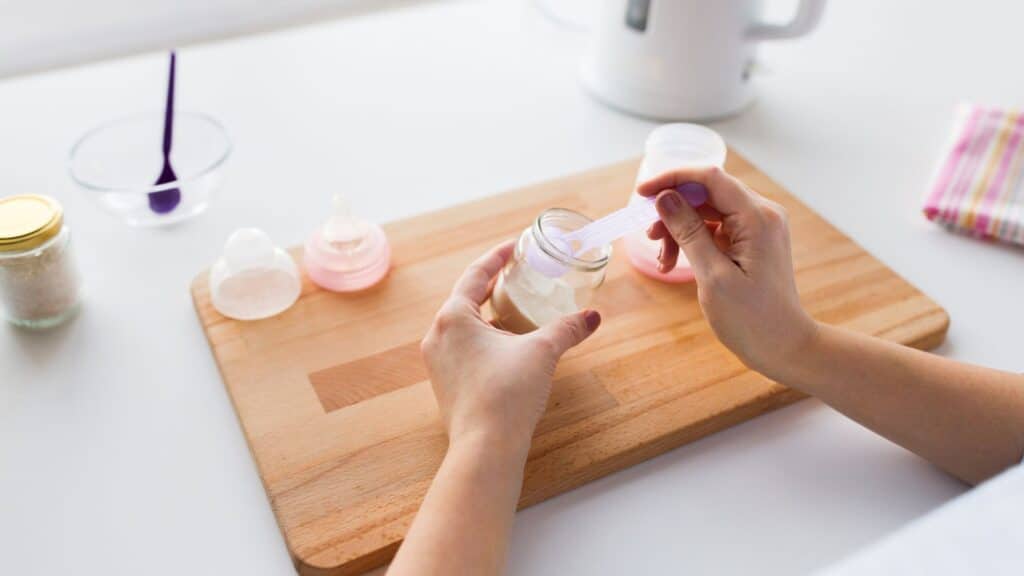
Here are some considerations to take into account when choosing a baby formula:
Understand the nutritional needs of your baby:
It is crucial to understand the nutritional needs of your baby before switching to an alternative baby formula. Consult with a healthcare professional to ensure that the formula you choose provides all the essential nutrients that your baby needs for healthy development.
Read labels carefully:
When choosing an alternative baby formula, read the labels carefully to understand the ingredients used. Look for formulas that use natural, organic ingredients and avoid those with added preservatives, additives, and artificial sweeteners.
Do your research:
Research the different types of alternative baby formulas available on the market. Some popular options include homemade formula, goat milk formula, and plant-based formulas. Be sure to research the pros and cons of each option and consult with a healthcare professional before making a switch.
Be aware of potential risks:
Homemade baby formula can be risky if not prepared correctly. Ensure that you follow a recipe that has been approved by a healthcare professional and that you use high-quality ingredients.
Monitor your baby’s response:
Keep an eye on your baby’s response to the alternative formula. Look for signs of allergy, intolerance, or digestive issues. If you notice any concerns, consult with a healthcare professional.
If you have concerns about the quality of ingredients found in commercial baby formulas, there are alternative options available.
However, it’s essential to understand your baby’s nutritional needs, read labels carefully, do your research, be aware of potential risks, and monitor your baby’s response when switching to an alternative formula.
By taking these considerations into account, you can make an informed decision about the best feeding option for your baby.
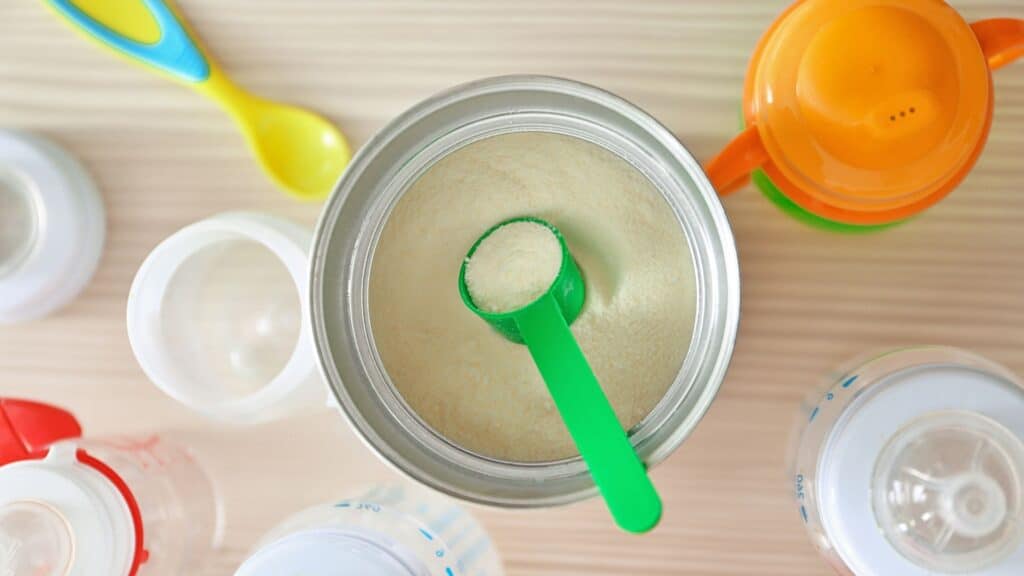
Conclusion
To conclude, ensuring proper baby formula mixing is vital for providing your baby with the appropriate balance of nutrients, calories, and hydration.
Possessing the right tools and adhering to best practices to prevent malnutrition, inadequate weight gain, developmental delays, dehydration, gastrointestinal distress, and kidney problems is crucial.
Fundamental tools for mixing baby formula encompass bottles, nipples, formula dispensers, measuring cups, bottle brushes, and sterilizers.
In contrast, advanced tools like formula makers, bottle warmers, and mixers can streamline the process, enhance efficiency, and guarantee a perfectly mixed formula each time.
By following these guidelines and best practices, you can offer your baby a secure, well-balanced, and nourishing diet, promoting optimal growth and overall well-being.
Did you find this article helpful? We’d love to hear your thoughts! If you have a question or comment, please let us know.

